Discover 35 hidden attractions, cool sights, and unusual things to do in Vienna (Austria). Don't miss out on these must-see attractions: Schönbrunn Palace, Kunsthistorisches Museum, and Belvedere. Also, be sure to include St. Stephen's Cathedral in your itinerary.
Below, you can find the list of the most amazing places you should visit in Vienna (Vienna).
Table of Contents
Schönbrunn Palace
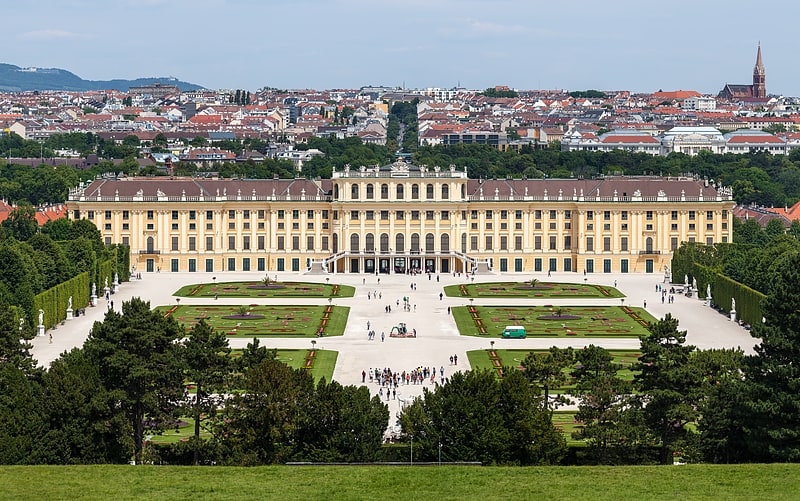
Also known as: Schloss Schönbrunn
Baroque palace with opulent interiors. Schönbrunn Palace was the main summer residence of the Habsburg rulers, located in Hietzing, Vienna. The name Schönbrunn has its roots in an artesian well from which water was consumed by the court.
The 1,441-room Rococo palace is one of the most important architectural, cultural, and historic monuments in the country. The history of the palace and its vast gardens spans over 300 years, reflecting the changing tastes, interests, and aspirations of successive Habsburg monarchs. It has been a major tourist attraction since the mid-1950s.[1]
Address: Schönbrunner Schloßstraße 47, 1130 Wien (Hietzing)
Kunsthistorisches Museum
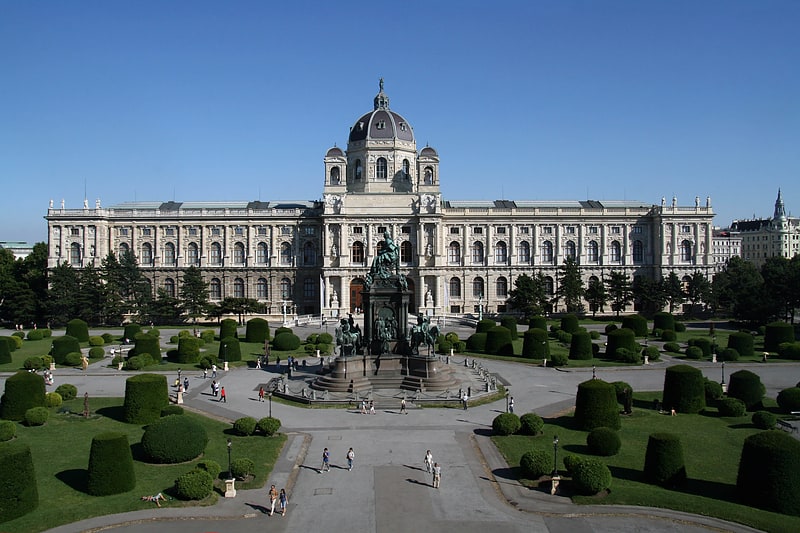
Fine arts museum in palatial building. The Kunsthistorisches Museum is an art museum in Vienna, Austria. Housed in its festive palatial building on Ringstraße, it is crowned with an octagonal dome. The term Kunsthistorisches Museum applies to both the institution and the main building. It is the largest art museum in the country and one of the most important museums worldwide.
Emperor Franz Joseph I of Austria-Hungary opened the facility around 1891 at the same time as the Natural History Museum, Vienna which has a similar design and is directly across Maria-Theresien-Platz. The two buildings were constructed between 1871 and 1891 according to plans by Gottfried Semper and Baron Karl von Hasenauer. The emperor commissioned the two Ringstraße museums to create a suitable home for the Habsburgs' formidable art collection and to make it accessible to the general public. The buildings are rectangular in shape, with symmetrical Renaissance Revival façades of sandstone lined with large arched windows on the main levels and topped with an octagonal dome 60 metres (200 ft) high. The interiors of the museums are lavishly decorated with marble, stucco ornamentation, gold-leaf, and murals. The grand stairway features paintings by Gustav Klimt, Ernst Klimt, Franz Matsch, Hans Makart and Mihály Munkácsy.[2]
Address: 5 Burgring, 1010, Wien, Vienna (Innere Stadt)
Belvedere
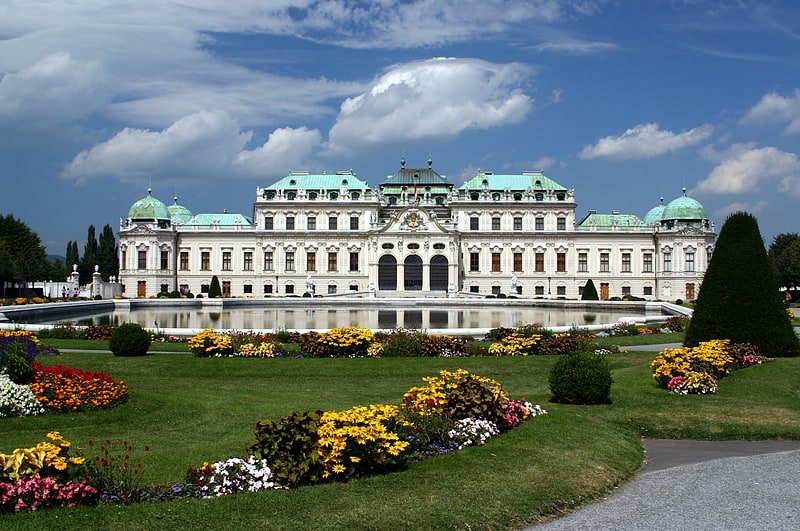
18th-century palaces with art collection. The Belvedere is a historic building complex in Vienna, Austria, consisting of two Baroque palaces, the Orangery, and the Palace Stables. The buildings are set in a Baroque park landscape in the third district of the city, on the south-eastern edge of its centre. It houses the Belvedere museum. The grounds are set on a gentle gradient and include decorative tiered fountains and cascades, Baroque sculptures, and majestic wrought iron gates. The Baroque palace complex was built as a summer residence for Prince Eugene of Savoy.
The Belvedere was built during a period of extensive construction in Vienna, which at the time was both the imperial capital and home to the ruling Habsburg dynasty. This period of prosperity followed on from the commander-in-chief Prince Eugene of Savoy's successful conclusion of a series of wars against the Ottoman Empire.[3]
Address: Prinz Eugen-Straße 27, 1030 Wien (Landstraße)
St. Stephen's Cathedral
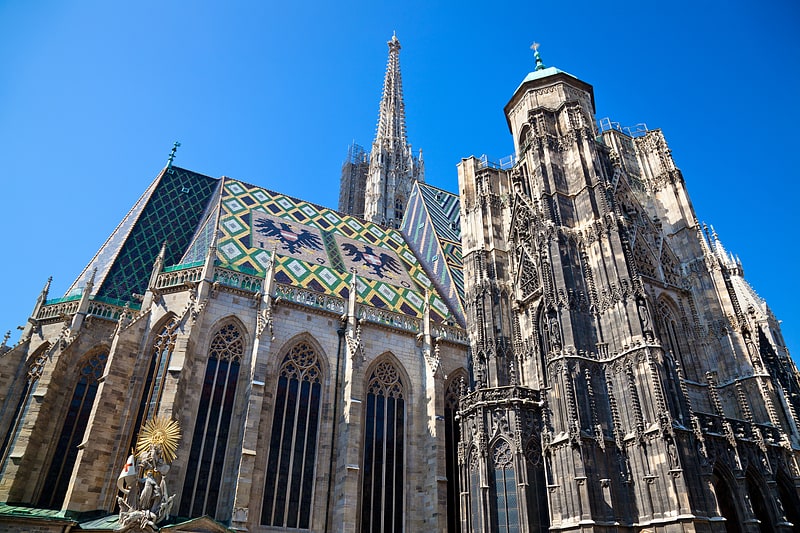
Also known as: Stephansdom
Medieval place of worship and city icon. St. Stephen's Cathedral is the mother church of the Roman Catholic Archdiocese of Vienna and the seat of the Archbishop of Vienna, Christoph Cardinal Schönborn, OP. The current Romanesque and Gothic form of the cathedral, seen today in the Stephansplatz, was largely initiated by Duke Rudolf IV and stands on the ruins of two earlier churches, the first a parish church consecrated in 1147. The most important religious building in Vienna, St. Stephen's Cathedral has borne witness to many important events in Habsburg and Austrian history and has, with its multi-coloured tile roof, become one of the city's most recognizable symbols.[4]
Address: Stephansplatz 3, 1010 Wien (Innere Stadt)
Hofburg

Baroque palace complex with museums. The Hofburg is the former principal imperial palace of the Habsburg dynasty. Located in the centre of Vienna, it was built in the 13th century and expanded several times afterwards. It also served as the imperial winter residence, as Schönbrunn Palace was the summer residence. Since 1946 it is the official residence and workplace of the president of Austria.
Since 1279 the Hofburg area has been the documented seat of government. The Hofburg has been expanded over the centuries to include various residences (with the Amalienburg and the Albertina), the imperial chapel (Hofkapelle or Burgkapelle), the imperial library (Hofbibliothek), the treasury (Schatzkammer), the Burgtheater, the Spanish Riding School (Hofreitschule), the imperial mews (Stallburg and Hofstallungen).
The palace faces the Heldenplatz (Heroes Square) ordered under the reign of Emperor Franz Joseph I, as part of what was planned to become the Kaiserforum but which was never completed.
Numerous architects have executed work at the Hofburg as it expanded, notably the Italian architect-engineer Filiberto Luchese, Lodovico Burnacini and Martino and Domenico Carlone, the Baroque architects Lukas von Hildebrandt and Joseph Emanuel Fischer von Erlach, Johann Fischer von Erlach, and the architects of the Neue Burg built between 1881 and 1913.[5]
Address: 1010 Vienna, Vienna (Innere Stadt)
Vienna State Opera

Also known as: Wiener Staatsoper
Vienna State Opera with museum . The Vienna State Opera is an opera house and opera company based in Vienna, Austria. The 1,709-seat Renaissance Revival venue was the first major building on the Vienna Ring Road. It was built from 1861 to 1869 following plans by August Sicard von Sicardsburg and Eduard van der Nüll, and designs by Josef Hlávka. The opera house was inaugurated as the "Vienna Court Opera" in the presence of Emperor Franz Joseph I and Empress Elisabeth of Austria. It became known by its current name after the establishment of the First Austrian Republic in 1921. The Vienna State Opera is the successor of the Vienna Court Opera, the original construction site chosen and paid for by Emperor Franz Joseph in 1861.
The members of the Vienna Philharmonic are recruited from the Vienna State Opera's orchestra. The building is also the home of the Vienna State Ballet, and it hosts the annual Vienna Opera Ball during the carnival season.[6]
Address: Opernring 2, 1010 Wien (Innere Stadt)
Spanish Riding School
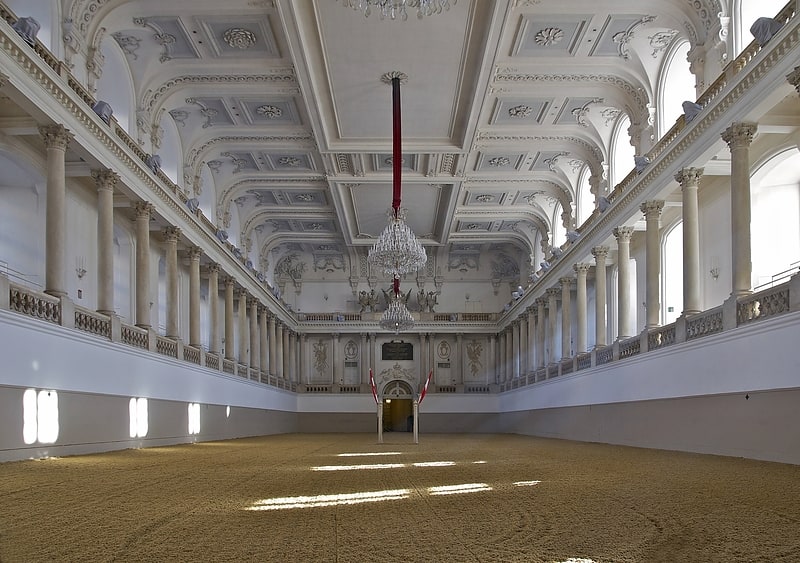
Also known as: Spanische Hofreitschule
Classical riding school with shows. The Spanish Riding School is an Austrian institution dedicated to the preservation of classical dressage and the training of Lipizzaner horses, based in Vienna, Austria, whose performances in the Hofburg are also a tourist attraction. The leading horses and riders of the school also periodically tour and perform worldwide. It is one of the "Big Four", the most prestigious classical riding academies in the world, alongside the Cadre Noir, the Portuguese School of Equestrian Art, and the Royal Andalusian School.[7]
Address: Michaelerplatz 1, 1010 Wien (Innere Stadt)
Graben
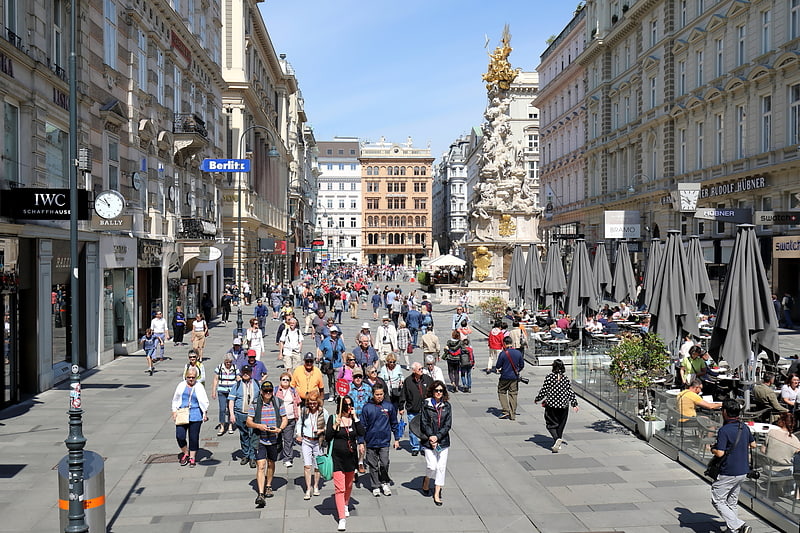
Street in Vienna, Austria. The Graben is one of the most famous streets in Vienna's first district, the city center. It begins at Stock-im-Eisen-Platz next to the Palais Equitable, and ends at the junction of Kohlmarkt and Tuchlauben. Another street in the first district is called Tiefer Graben. It is crossed by Wipplinger Straße by means of the Hohe Brücke, a bridge about 10 meters above street level.[8]
Address: Graben 19, 1010 Vienna (Innere Stadt)
Karlskirche
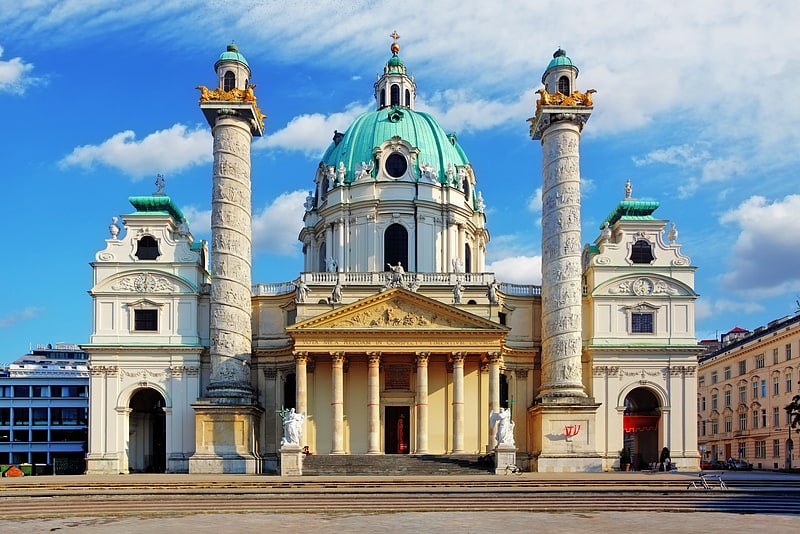
Baroque cathedral and viewing platform. The Rektoratskirche St. Karl Borromäus, commonly called the Karlskirche, is a Baroque church located on the south side of Karlsplatz in Vienna, Austria. Widely considered the most outstanding baroque church in Vienna, as well as one of the city's greatest buildings, the church is dedicated to Saint Charles Borromeo, one of the great counter-reformers of the sixteenth century.
Located just outside of Innere Stadt in Wieden, approximately 200 meters outside the Ringstraße, the church contains a dome in the form of an elongated ellipsoid.[9]
Address: Kreuzherrengasse 1, 1040 Vienna
Albertina
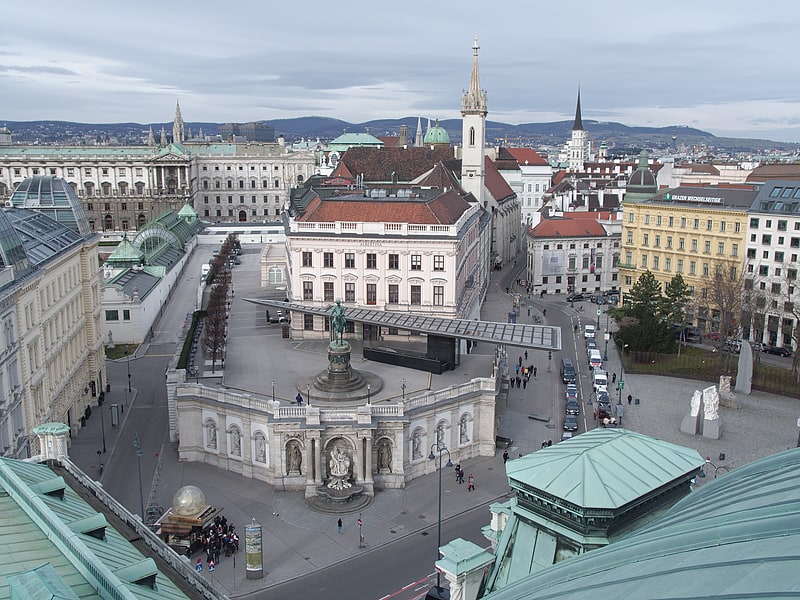
Art museum housed in Habsburg palace. The Albertina is a museum in the Innere Stadt of Vienna, Austria. It houses one of the largest and most important print rooms in the world with approximately 65,000 drawings and approximately 1 million old master prints, as well as more modern graphic works, photographs and architectural drawings. Apart from the graphics collection the museum has recently acquired on permanent loan two significant collections of Impressionist and early 20th-century art, some of which will be on permanent display. The museum also houses temporary exhibitions. The museum had 360,073 visitors in 2020, down 64 percent from 2019 due to the COVID-19 pandemic, but still ranked 55th in the List of most-visited art museums in the world.[10]
Address: Albertinaplatz 1, 1010 Wien (Innere Stadt)
Gloriette
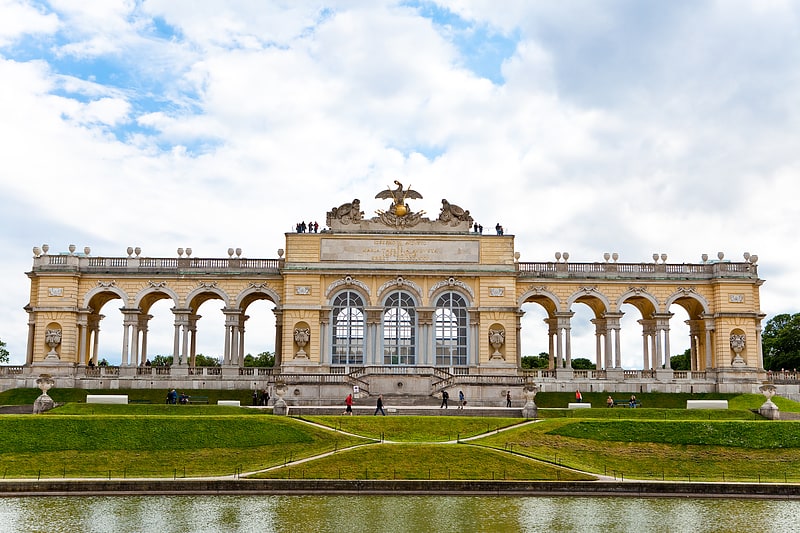
A gloriette is a building in a garden erected on a site that is elevated with respect to the surroundings. The structural execution and shape can vary greatly, often in the form of a pavilion or tempietto, more or less open on the sides.[11]
Address: Schönbrunner Schlosspark, Vienna (Hietzing)
Natural History Museum
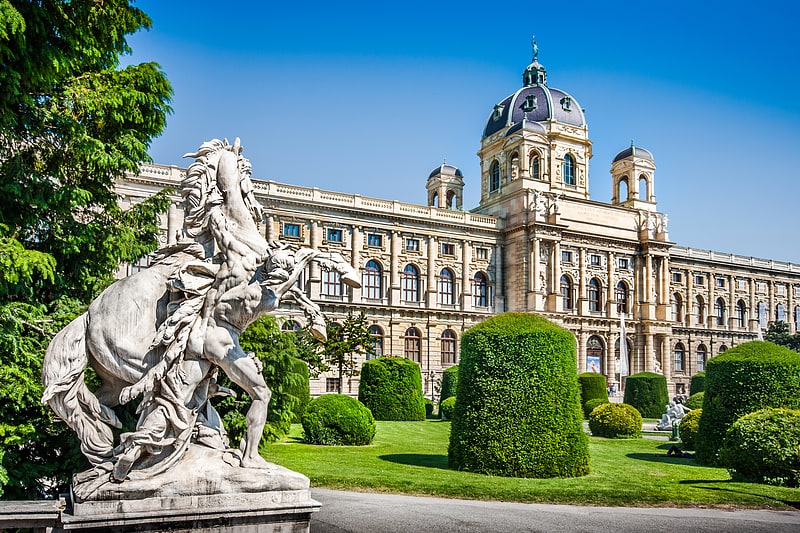
Also known as: Naturhistorisches Museum Wien
Museum in Vienna, Austria. The Natural History Museum Vienna is a large natural history museum located in Vienna, Austria. It is one of the most important natural history museums worldwide.
The NHM Vienna is one of the largest museums and non-university research institutions in Austria and an important center of excellence for all matters relating to natural sciences. The museum's 39 exhibition rooms cover 8,460 square meters and present more than 100,000 objects. It is home to 30 million objects available to more than 60 scientists and numerous guest researchers who carry out basic research in a wide range of topics related to human sciences, earth sciences, and life sciences.
The Index Herbariorum code assigned to this museum is W and it is used when citing housed herbarium specimens.[12]
Address: Burgring 7, 1010 Wien (Innere Stadt)
Austrian Parliament Building
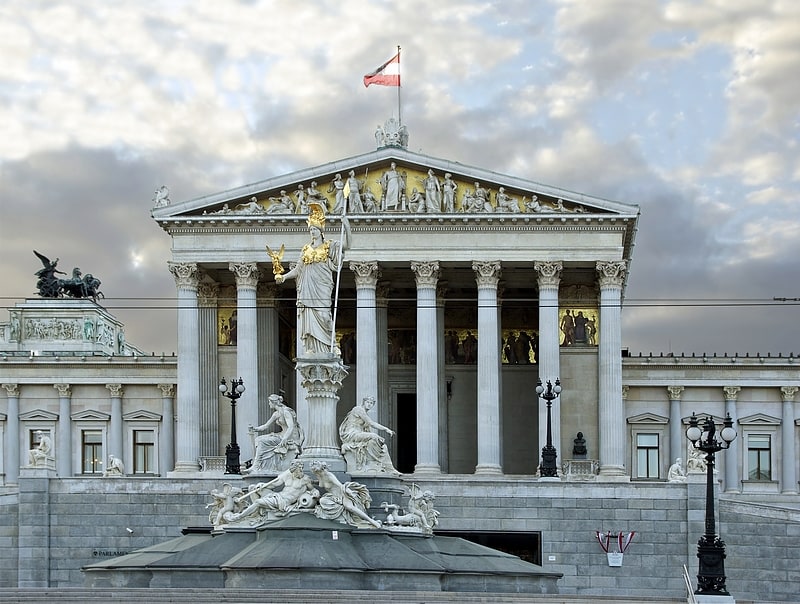
Also known as: Parlamentsgebäude
Building in Vienna, Austria. The Austrian Parliament Building in Vienna is where the two houses of the Austrian Parliament conduct their sessions. The building is located on the Ringstraße boulevard in the first district Innere Stadt, near Hofburg Palace and the Palace of Justice. It was built to house the two chambers of the Imperial Council, the bicameral legislature of the Cisleithanian part of the Austro-Hungarian Empire. Since its construction, the Parliament Building has been the seat of these two houses, and their successors—the National Council and the Federal Council —of the Austrian legislature.
The foundation stone was laid in 1874; the building was completed in 1883. The architect responsible for its Greek Revival style was Theophil Hansen. He designed the building holistically, aiming to have each element harmonising with all the others. He was therefore also responsible for the interior decoration, such as statues, paintings, furniture, chandeliers, and numerous other elements. Hansen was honoured by Emperor Franz Joseph with the title of Freiherr (Baron) after its completion. Following heavy damage and destruction in World War II, most of the interior has been restored to its original splendour.
The parliament building covers over 13,500 square meters, making it one of the largest structures on Ringstraße. It contains over one hundred rooms, the most important of which are the Chambers of the National Council, the Federal Council, and the former Imperial House of Representatives (Abgeordnetenhaus). The building also includes committee rooms, libraries, lobbies, dining rooms, bars and gymnasiums. One of the building's most famous features is the Pallas Athena fountain in front of the main entrance, built by Carl Kundmann after plans from Hansen, from 1898 to 1902 and it is a notable Viennese tourist attraction.
The Parliament Building is the site of important state ceremonies, most notably the swearing-in ceremony of the President of Austria and the state speech on National Day each October 26. The building is closely associated with the two parliamentary bodies, as is shown by the use of the term Hohes Haus as a metonym for "Parliament". Parliamentary offices spill over into nearby buildings, such as the Palais Epstein.[13]
Address: Dr.-Karl-Renner-Ring 3, 1017 Wien (Innere Stadt)
Tiergarten Schönbrunn

Zoo founded in the 18th century. Tiergarten Schönbrunn – Schönbrunn Zoo – was established by the Habsburgs in the park of Schönbrunn Palace in Vienna’s 13th district of Hietzing in 1752 and is today the world’s oldest zoo that is still in operation. Zoologist Stephan Hering-Hagenbeck has been the zoo’s director since 2020. Schönbrunn Zoo has been recording more than two million visitors every year since 2006. It presents around 8,000 animals from 700 species on an area of 17 hectares. Anthony Sheridan’s zoo rankings recognised Schönbrunn Zoo as the best zoo in Europe five times in a row.[14]
Address: Maxingstraße 13b, 1130 Wien (Hietzing)
Donauturm

Iconic tower with observation terrace. The Donauturm is a tower in Vienna, the tallest structure in Austria at 252 metres, and is the 68th tallest tower in the world. Opening in April 1964, the tower is located near the north bank of the Danube River in the district of Donaustadt.[15]
Address: Donauturmstrasse 4, 1220 Vienna (Donaustadt)
Mozart Statue
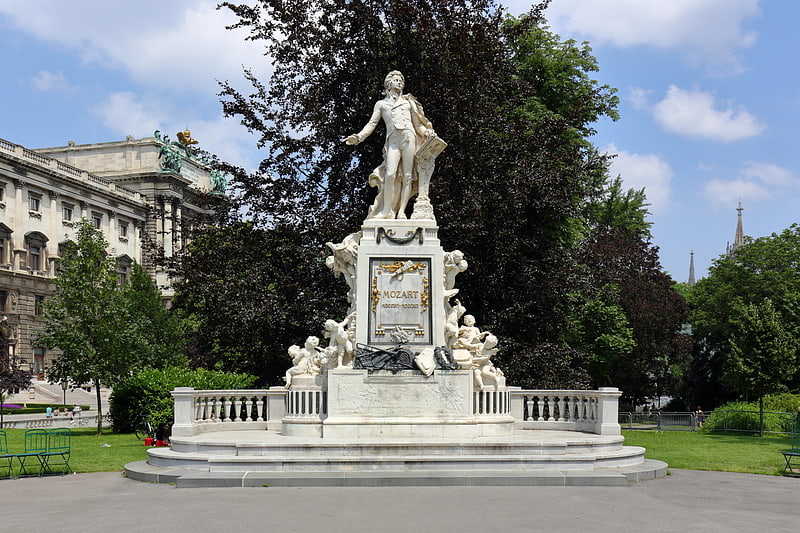
Sculpture in Vienna, Austria. The Mozart Monument is a monument located in the Burggarten in the Innere Stadt district of Vienna, Austria since 1953. It is dedicated to composer Wolfgang Amadeus Mozart.
This 7.5-meter-high statue was made by architect Karl König (1841–1915) and sculptor Viktor Tilgner (1844–1896) and was unveiled at Albrechtsplatz (today Albertinaplatz) on April 21, 1896, five days after Tilgner died. Tilgner's signature was completed with his death date.[16]
Sculptures in the Schönbrunn Garden
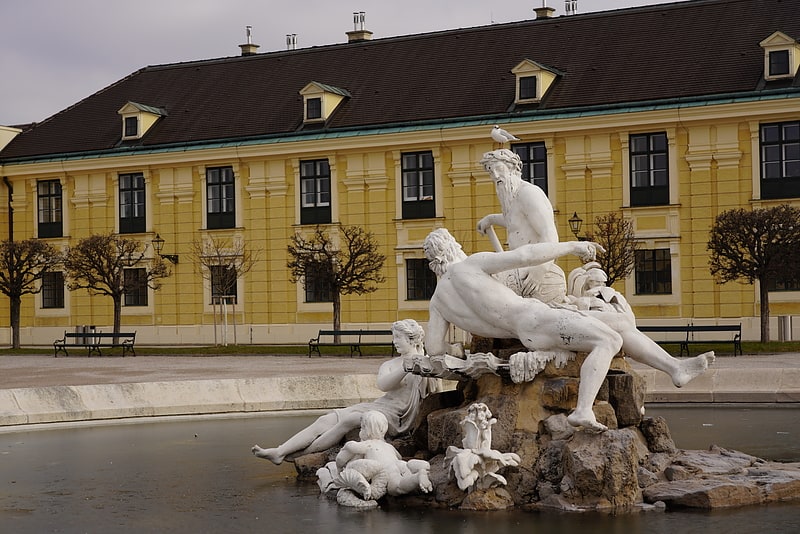
Also known as: Skulpturen und Plastiken um Schloss Schönbrunn
The sculptures in the Schönbrunn Garden at Schönbrunn Palace in Vienna, Austria were created between 1773 and 1780 under the direction of Johann Wilhelm Beyer, a German artist and garden designer. The Great Parterre of Schönbrunn Garden is lined on both sides with 32 over life-size sculptures that represent mythological deities and virtues. The Neptune Fountain at the foot of the Gloriette hill is the crowning monument of the Great Parterre. Other sculptures are distributed throughout the garden and palace forecourt, including fountains and pools. Several sculptors were employed during the execution of these works, among them Johann Baptist Hagenauer.[17]
Address: Schönbrunner Schloßstr., 1130 Wien (Hietzing)
Museum of Military History
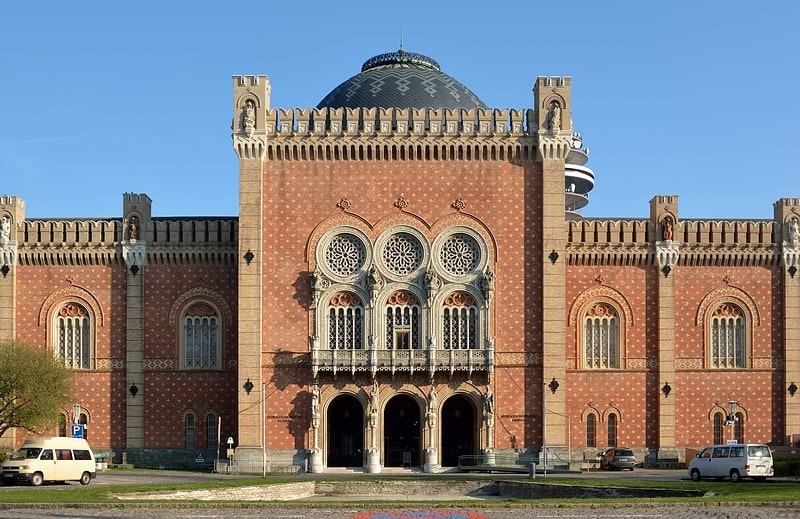
Also known as: Heeresgeschichtliches Museum
World's oldest purpose military museum. The Museum of Military History – Military History Institute in Vienna is the leading museum of the Austrian Armed Forces. It documents the history of Austrian military affairs through a wide range of exhibits comprising, above all, weapons, armours, tanks, aeroplanes, uniforms, flags, paintings, medals and badges of honour, photographs, battleship models, and documents. Although the museum is owned by the Federal Government, it is not affiliated to the Federal museums but is organised as a subordinate agency reporting directly to the Ministry of Defence and Sports.[18]
Address: Arsenal 1, 1030 Wien (Landstraße)
Vienna Secession

Also known as: Wiener Secession
Art movement. The Vienna Secession is an art movement, closely related to Art Nouveau, that was formed in 1897 by a group of Austrian painters, graphic artists, sculptors and architects, including Josef Hoffman, Koloman Moser, Otto Wagner, and Gustav Klimt. They resigned from the Association of Austrian Artists in protest against its support for more traditional artistic styles. Their most influential architectural work was the Secession Building designed by Joseph Maria Olbrich as a venue for expositions of the group. Their official magazine was called Ver Sacrum, which published highly stylised and influential works of graphic art. In 1905 the group itself split, when some of the most prominent members, including Klimt, Wagner, and Hoffmann, resigned in a dispute over priorities, but it continued to function, and still functions today, from its headquarters in the Secession Building. In its current form, the Secession exhibition gallery is independently led and managed by artists.[19]
Address: Friedrichstraße 12, Vienna (Mariahilf)
Hundertwasserhaus
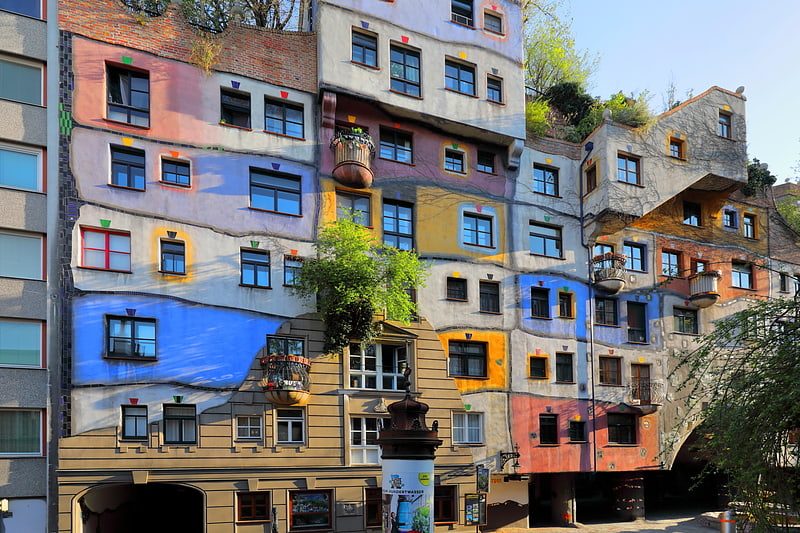
Apartment in Vienna, Austria. The Hundertwasserhaus is an apartment house in Vienna, Austria, built after the idea and concept of Austrian artist Friedensreich Hundertwasser.[20]
Address: Kegelgasse 36, 1030 Wien (Landstraße)
City Hall
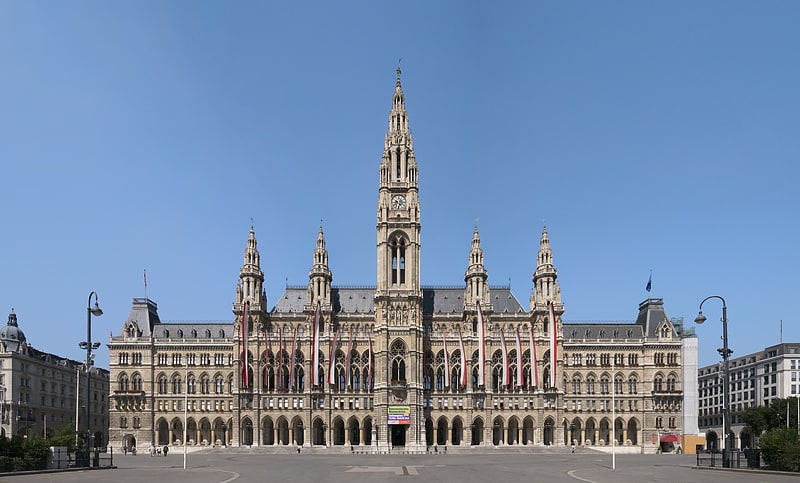
Also known as: Wiener Rathaus
Neo-Gothic city hall built 1872-1883. Vienna City Hall is the seat of local government of Vienna, located on Rathausplatz in the Innere Stadt district. Constructed from 1872 to 1883 in a Neo-Gothic style according to plans designed by Friedrich von Schmidt, it houses the office of the Mayor of Vienna as well as the chambers of the city council and Vienna Landtag diet. For a brief period between 1892-1894, the Vienna City Hall was the world's tallest building, until it was eclipsed by Milwaukee City Hall.[21]
Address: Rathausplatz 1, 1010 Vienna (Innere Stadt)
Urania
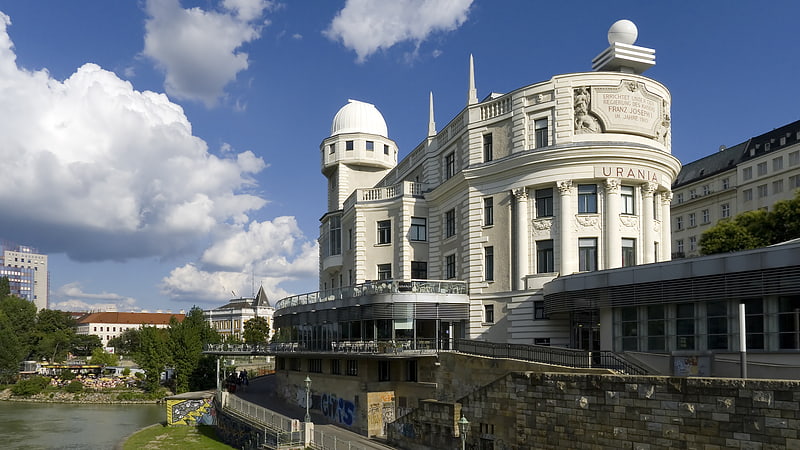
Planetarium in Vienna, Austria. Urania is a public educational institute and observatory in Vienna, Austria.
Urania Observatory (German: Urania Sternwarte) was built in 1909 according to the plans of Art Nouveau style architect Max Fabiani (a student of Otto Wagner) at the outlet of the Wien River and was opened in 1910 by Franz Joseph I of Austria as an educational facility with a public observatory. It was named after the Muse Urania who represents Astronomy.
During World War II, the Urania was severely damaged and the dome with the observatory was destroyed. After its reconstruction, it was reopened in 1957. The observatory itself has been continually improved technically over the years.
Though it now serves different functions, the Urania continues to be a public observatory. Presently the Urania also has seminar rooms in which wide-ranging classes and lectures are given, a movie theater that screens at the annual Viennale movie festival and a puppet theater created originally by actor Hans Kraus. The Urania moreover contains a memorial room for the Kindertransport organized by the Dutch resistance fighter and humanitarian Mrs Gertruida Wijsmuller-Meijer, who early December 1938 managed to rescue the first 600 Jewish children from Vienna after direct negotiations in Vienna with Adolf Eichmann. It also hosts a restaurant, and is the oldest public observatory in Austria. The highly awarded Austrian writer Carl Julius Haidvogel once worked there as an editor.[22]
Address: Uraniastraße 1, 1010 Wien (Innere Stadt)
Maria-Theresien-Platz
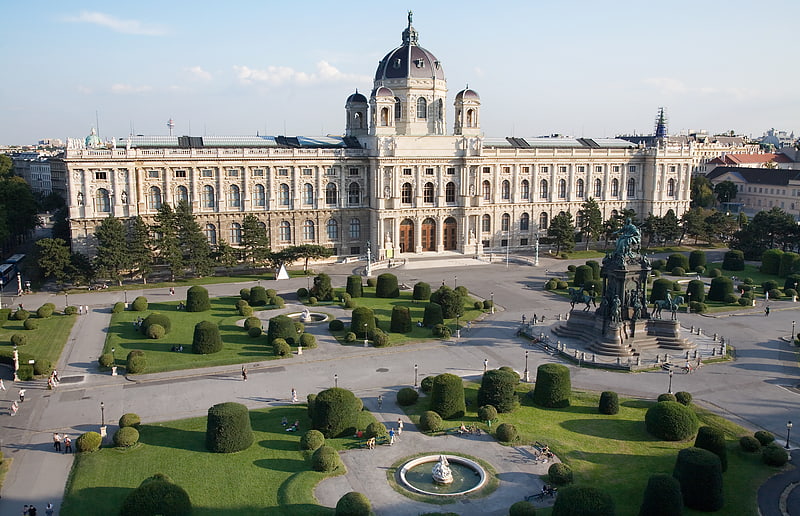
Plaza in Vienna, Austria. Maria-Theresien-Platz is a large public square in Vienna, Austria, that joins the Ringstraße with the Museumsquartier, a museum of modern arts located in the former Imperial Stables. Facing each other from the sides of the square are two near identical buildings, the Naturhistorisches Museum and the Kunsthistorisches Museum. The buildings are near identical, except for the statuary on their façades. The Naturhistorisches' façade has statues depicting personifications of Africa, Asia, Europe, and the Americas. The Kunsthistorisches façade features famous European artists, such as the Dutch Bruegel, among others.
The Naturhistorisches Museum and the Kunsthistorisches Museum and the square adjoining them were built in 1889. At the center of the square is a large statue depicting Empress Maria Theresa, namesake of the square. The Modern Art Museum in the former Imperial Stables shows contemporary works that some may consider controversial. The three museums are popular destinations for tourists.
The Kunsthistorisches Museum contains numerous famous works by the Northern European masters, such as Bruegel's Tower of Babel, as well as an extensive collection of ancient world art. The Egyptian collection (Aegyptisches Sammlung) houses mummified forms, stone carvings, and the tomb of an Egyptian prince that was transported to Vienna and reassembled for Emperor Franz Joseph I of Austria. On the stairwell's roof are frescoes by Austrian artist Gustav Klimt.
The Naturhistorisches Museum houses displays of butterflies and other insects, and an extensive preserved and stuffed animal collection, the most poignant examples of which include a Przewalskii's horse, a baby Javanese rhinoceros, and a case of dodo remains. Also notable is the museum's famous Mikrotheater, showing slides of microscopic organisms, its two spider crabs which were sent to Emperor Franz Joseph by the Japanese Emperor as a gift, and the first ever human depiction of an underwater scene made from life observation and the diving bell from which it was made. The stairwell contains paintings of Emperor Franz Joseph, Empress Maria Theresa and her stuffed pet lap dog, a miniature hound.[23]
Address: Maria Theresa Square, 1010 Vienna (Innere Stadt)
Schlosstheater Schönbrunn
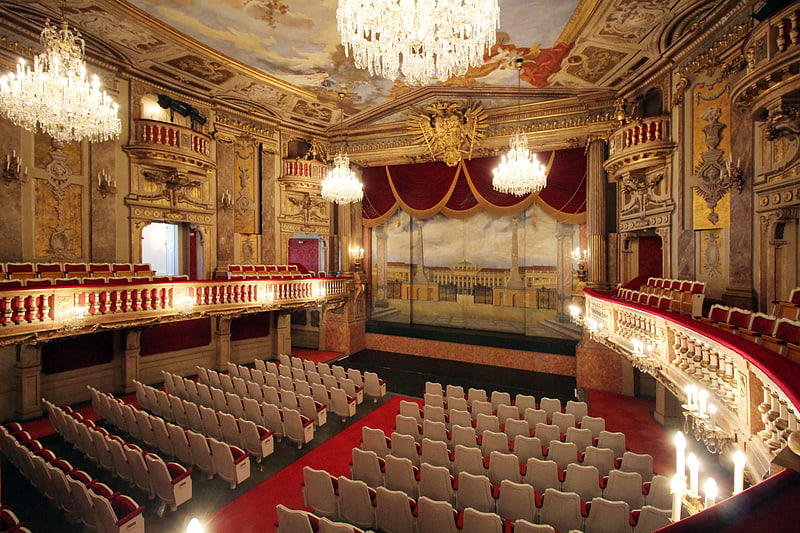
Schlosstheater Schönbrunn is a stage at Schönbrunn Palace in Vienna which opened in 1747. The Baroque theatre now serves for the training of students of acting and opera of the University of Music and Performing Arts Vienna, and for performances of the Musik Theater Schönbrunn.[24]
Heldenplatz

Public square with green space and statues. Heldenplatz is a public space in front of the Hofburg Palace in Vienna, Austria. Located in the Innere Stadt borough, the President of Austria resides in the adjoining Hofburg wing, while the Federal Chancellery is on adjacent Ballhausplatz.
Many important actions and events took place here, most notably Adolf Hitler's ceremonial announcement of the Austrian Anschluss to Nazi Germany on 15 March 1938.[25]
Memorial against war and fascism

Cultural landmark in Vienna, Austria. The memorial against war and fascism is a work by the Austrian sculptor Alfred Hrdlicka. It has been standing since 1988 on the Albertinaplatz in Vienna – named after Helmut Zilk in 2009 – opposite the Palais Archduke Albrecht and the back of the Vienna State Opera. As a walk-in monument, it is intended to serve as a reminder of the darkest epoch in Austrian history. It is dedicated to all victims of war and fascism.[26]
Stock im Eisen
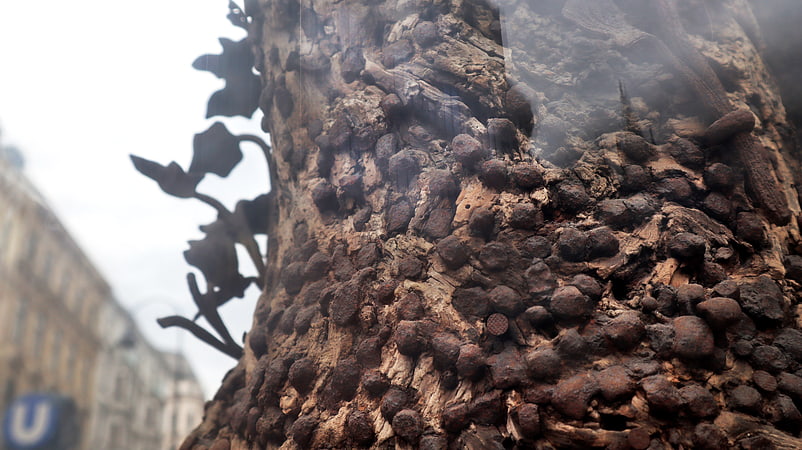
Also known as: Stock-im-Eisen
Historical landmark in Vienna, Austria. The Stock im Eisen is the midsection of a tree-trunk from the Middle Ages, a so-called nail-tree, into which hundreds of nails have been pounded for good luck over centuries. It is located in Vienna, Austria, in Stock-im-Eisen-Platz, now part of Stephansplatz, at the corner of the Graben and Kärntner Straße and is now behind glass on a corner of the Palais Equitable.[27]
Haus des Meeres
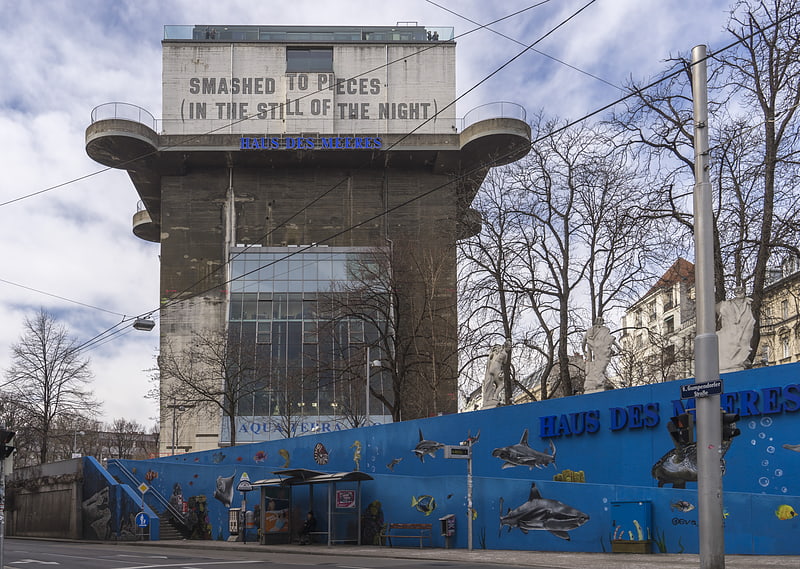
Aquarium with sharks and crocodiles. The Haus des Meeres is a public aquarium in Vienna, Austria. It is located in Esterhazy Park in downtown Mariahilf district, one block south of the busy Mariahilfer Straße. The Haus des Meeres houses over ten thousand aquatic beings on an area of around 4,000 square meters inside a tall concrete flak tower built during World War II. In 2012 the Haus des Meeres attracted a record high of 650,000 visitors. The Haus des Meeres is managed by Aqua Terra Zoo, a private non-profit organization which, according to its web site, receives only marginal financial support from municipal authorities. However, the maintenance costs for the former flak tower are paid by the taxpayer.[28]
Address: Fritz-Grünbaum-Platz 1, 1060 Wien (Mariahilf)
Palais Erzherzog Ludwig Viktor
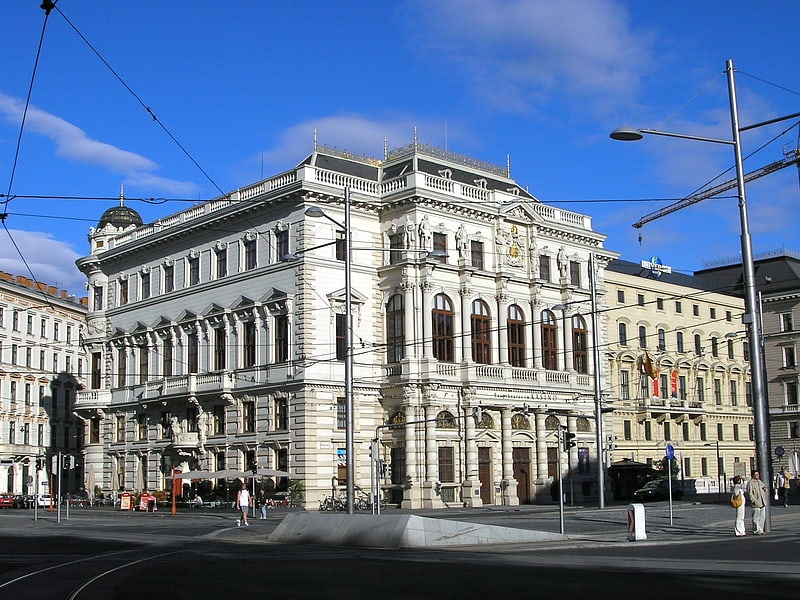
Tourist attraction in Vienna, Austria. The Palais Erzherzog Ludwig Viktor is one of the best known Ringstraßenpalais in Vienna. It was built between 1863 and 1866. The first building to be built on the Schwarzenbergplatz, it is now a subsidiary house of the Burgtheater.[29]
Address: 1 Schwarzenbergplatz, Vienna (Innere Stadt)
Österreichische Galerie Belvedere
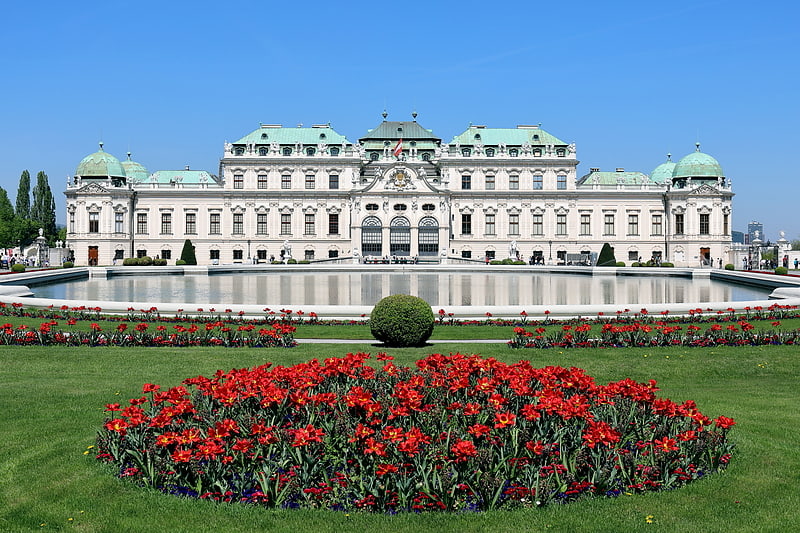
Museum in Vienna, Austria. The Österreichische Galerie Belvedere is a museum housed in the Belvedere palace, in Vienna, Austria.
The Belvedere palaces were the summer residence of Prince Eugene of Savoy (1663–1736). The ensemble was built in the early eighteenth century by the famous Baroque architect, Johann Lucas von Hildebrandt, and comprises the Upper and Lower Belvedere, with the Orangery and Palace Stables, as well as extensive gardens. As one of Europe's most stunning Baroque landmarks, it is listed as a UNESCO World Heritage Site.
Today, the Belvedere houses the greatest collection of Austrian art dating from the Middle Ages to the present day, complemented by the works of international artists. At the Upper Belvedere, visitors not only encounter artworks drawn from over five hundred years of art history but can also experience the magnificent staterooms. In addition to the Lower and Upper Belvedere, the museum has further sites at Prince Eugene's town palace and the 21er Haus as well as the Gustinus Ambrosi Museum.
The Belvedere's art collection presents an almost complete overview of the development of art in Austria and, thus, an insight into the country's history. The world's largest collection of Gustav Klimt's paintings lies at the heart of the presentation of Art around 1900, on show at the Upper Belvedere. Its highlights are Klimt's paintings, The Kiss (1908/09) and Judith and the Head of Holofernes (1901), and masterpieces by Egon Schiele and Oskar Kokoschka. Key works of French Impressionism and the greatest collection of Viennese Biedermeier art are further attractions at the museum.[30]
Address: Prinz Eugen-Straße 27, 1030 Wien (Landstraße)
Leopold Museum
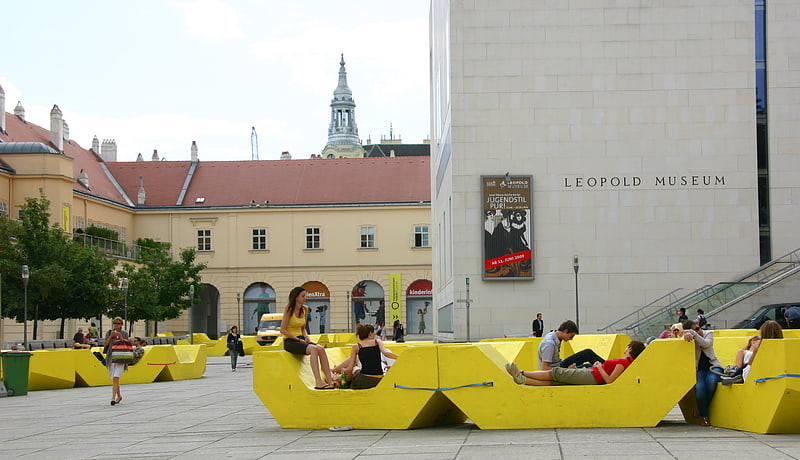
Collection of modern Austrian art and cafe. The Leopold Museum, housed in the Museumsquartier in Vienna, Austria, is home to one of the largest collections of modern Austrian art, featuring artists such as Egon Schiele, Gustav Klimt, Oskar Kokoschka and Richard Gerstl.
It contains the world's largest Egon Schiele Collection.
The more than 5,000 exhibits collected by Elisabeth and Rudolf Leopold over five decades were consolidated in 1994 with the assistance of the Republic of Austria and the National Bank of Austria into the Leopold Museum Private Foundation. In 2001 the Leopold Museum was opened.
The core of the collection consists of Austrian art of the first half of the 20th century, including key paintings and drawings by Egon Schiele and Gustav Klimt, showing the gradual transformation from the Wiener Secession, the Art Nouveau/Jugendstil movement in Austria to Expressionism. The historical context is illustrated by major Austrian works of art from the 19th and 20th centuries.[31]
Address: Museumsplatz 1, 1070 Wien (Neubau)
Naschmarkt
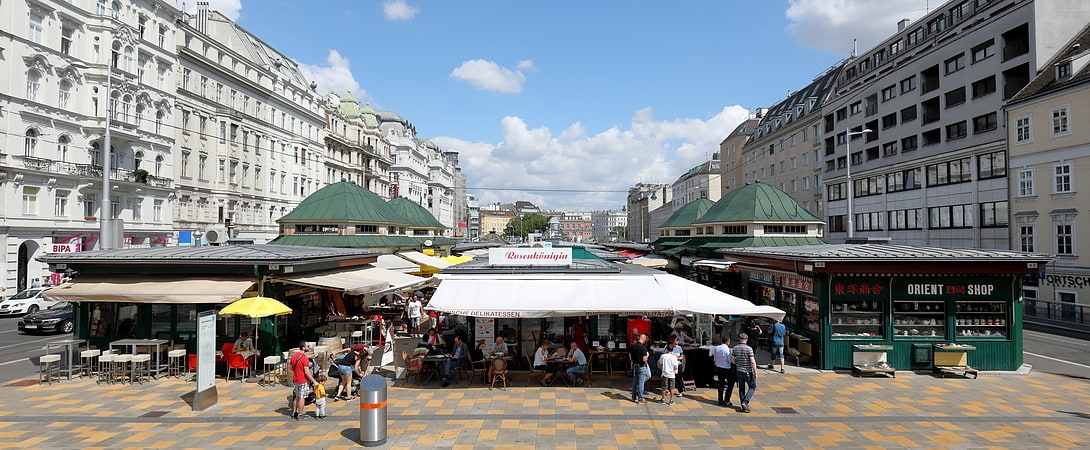
Vienna's biggest market for food and more. The Naschmarkt is Vienna's most popular market. Located at the Wienzeile over the Wien River, it is about 1.5 kilometres long.
The Naschmarkt has existed since the 16th century when mainly milk bottles were sold (as milk bottles were made out of ash (wood from an ash tree), "Asch" (German for "ash") led to the name "Aschenmarkt"). From 1793 onwards, all fruits and vegetables brought to Vienna with carts had to be sold there, while goods arriving on the Danube were sold elsewhere. Nowadays, one can buy fresh fruit and vegetables from around the world, exotic herbs, cheese, baked goods such as bread, kaiser rolls, torte, meats, and seafood. There are also many small restaurants which offer e.g. sushi, kebab, seafood, traditional Viennese food such as Kaiserschmarrn or Palatschinken (rolled up crepes) and stalls which offer clothes and accessories. Since 1977, the market extends further along the Wienzeile to an adjacent area every Saturday, when a flea market takes place there.
The atmosphere of the Naschmarkt is famous far beyond the borders of Vienna, and large numbers of tourists visit the market every year.[32]
Address: 1060 Vienna, Vienna
Karlsplatz
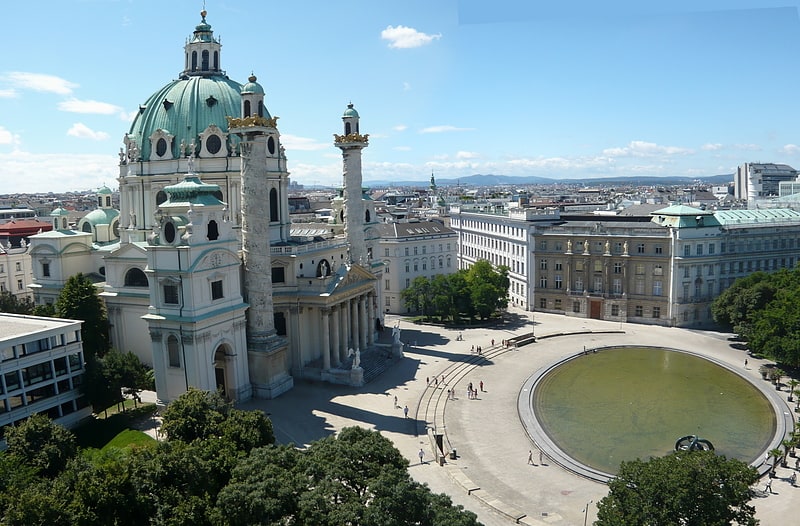
Karlsplatz is a town square on the border of the first and fourth districts of Vienna. It is one of the most frequented and best connected transportation hubs in Vienna. The Karlskirche is located here.
The first district can be reached either by subway (Karlsplatz station) or via Operngasse (a street). The pavilions of the former Karlsplatz Stadtbahn Station remain despite the construction of the U-Bahn system.[33]
Pestsäule
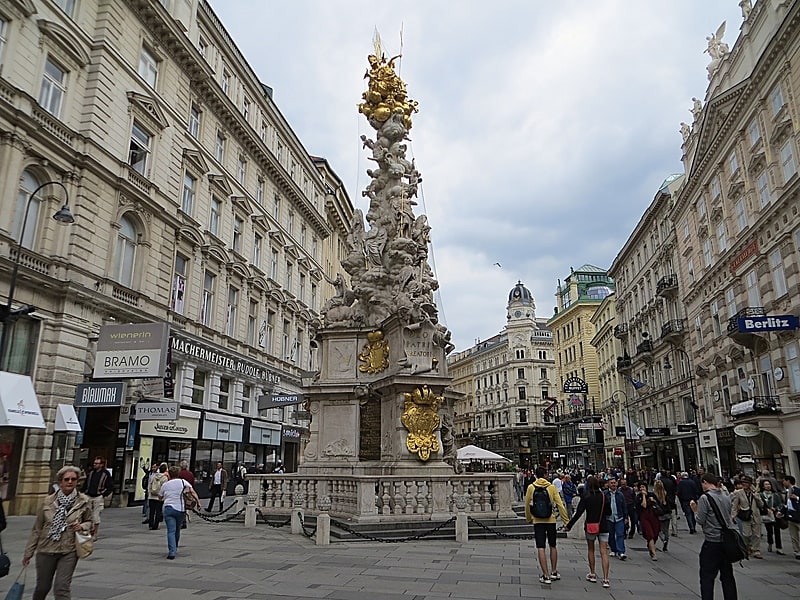
Memorial column for plague victims. The Plague Column, or Trinity Column, is a Holy Trinity column located on the Graben, a street in the inner city of Vienna, Austria. Erected after the Great Plague epidemic in 1679, the Baroque memorial is one of the most well-known and prominent sculptural pieces of art in the city. Christine M. Boeckl, author of Images of Plague and Pestilence, calls it "one of the most ambitious and innovative sculptural ensembles created anywhere in Europe in the post-Bernini era."[34]
Address: Graben 26, 1010 Vienna (Innere Stadt)
Votivkirche
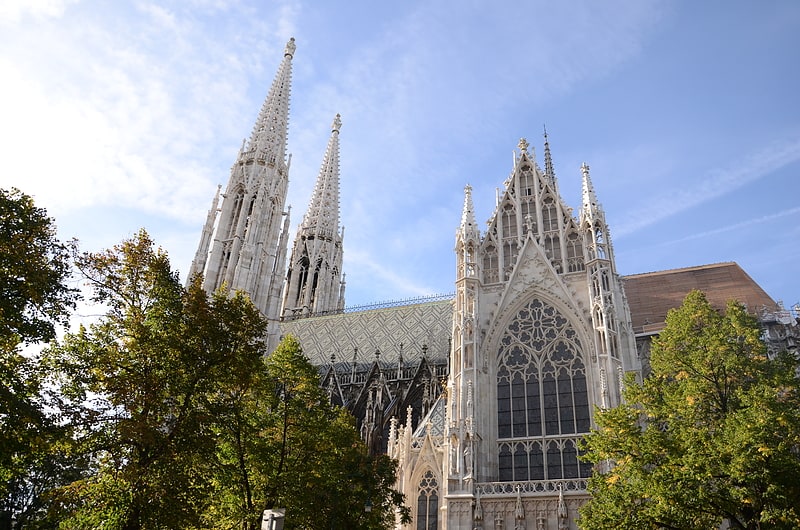
Neo Gothic church with an on-site museum. The Votivkirche is a neo-Gothic style church located on the Ringstraße in Vienna, Austria. Following the attempted assassination of Emperor Franz Joseph in 1853, the Emperor's brother Archduke Ferdinand Maximilian inaugurated a campaign to create a church to thank God for saving the Emperor's life. Funds for construction were solicited from throughout the Empire. The church was dedicated in 1879 on the silver anniversary of Emperor Franz Joseph and his wife Empress Elisabeth.[35]
Address: Rooseveltplatz 8, 1090 Wien (Alsergrund)